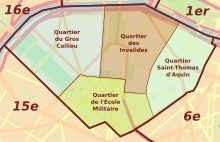Quartier du Gros-Caillou
Coordinates: 48 ° 51 ' N , 2 ° 18' E
| Quartier du Gros-Caillou | |
|---|---|
| administration | |
| Country | France |
| region | Île-de-France |
| Arrondissement | 7th |
| Demographics | |
| Transport links | |
| metro | |

within the 7th arrondissement
The Quartier du Gros-Caillou is the 28th district of Paris and is located in the 7th arrondissement .
etymology
At the beginning there was certainly a natural boundary marking by an (apparently) prehistoric monolith , which marked the boundary between the Seigneuries Saint-Germain and Sainte-Geneviève. This place, which was mentioned for the first time in 1510 and 1523, was also called "Vert-Buisson".
history
In the 19th century, there was a tobacco factory here on the Quai d'Orsay . In the vicinity there was a further processing of offal and a steam-powered pumping station , so that the place was considered as "one of the largest factory settlements of Paris with thousands of workers" and "one of the worst places of industrial pollution ". In 1828, the chemist Jean Pierre Joseph d'Arcet had a fourneau à réverbère fumivore (stove with a lantern- like chimney ) set up to reduce the exhaust gases. Further attempts in the area of hygiene to get air pollution under control failed, however, and the Conseil d'hygiène publique et de salubrité (Council for Public Health and Hygiene) noted a “negligence” in the “use of smoke-reducing agents” and thus the Eligibility of "justified" complaints from neighbors. In contrast, Maxime Du Camp was able to confirm in the Revue des Deux Mondes in 1868 :
"Two immense cheminées en brique garnies de paratonnerres semblent inutiles, car jamais nul panache de fumée ne les couronne. On entend cependant le bruit régulier des machines à vapeur et le ronflement des foyers qui dévorent le charbon. »
“Two huge brick chimneys fitted with lightning rods seem useless, since no plume of smoke can ever crown them. However, you can hear the regular noise of steam engines and the humming of coal-fired fireplaces. "
The factory was finally closed in 1905 and demolished in 1909. The tobacco factory in Issy-les-Moulineaux was built in its place between 1900 and 1904 .
important addresses
Attractions
Embassies
- Embassy of Bulgaria , Avenue Rapp
- Embassy of Costa Rica , Square Rapp
- Embassy of Romania , Rue de l'Exposition
- Embassy of Senegal , Avenue Robert-Schuman
Green spaces
Churches
- Trinity Cathedral , Quai Branly
- Église Saint-Pierre-du-Gros-Caillou , Rue Saint-Dominique
- Église américaine de Paris , Quai d'Orsay
Personalities from the neighborhood
- Jules Rimet , born 30 kilometers west of Vesoul and founder of FIFA , is said to have lived in his youth at 188, Rue de Grenelle .
- Jules Lavirotte built an Art Nouveau style house at 29, Avenue Rapp , which was declared a monument historique in 1964 .
Individual evidence
- ↑ Pascal Ory , Le Palais de Chaillot , Arles, Aristeas / Actes Sud, 2006, 144 pp., ISBN 978-2-7427-6392-4 , pp. 12-14
- ^ Adolphe Berty, Henry Legrand, Lazare Maurice Tisserand and Théodore Vacquer, Topographie historique du vieux Paris , Imprimerie impériale, 1882, p. 31
- ↑ a b c Thomas Le Roux, Le Laboratoire des pollutions industrielles. Paris 1770-1830 , Albin Michel, 2011, pp. 379-380.
- ^ Maxime Du Camp , Les manufactures de tabac. Les établissemens du Gros-Caillou et de Reuilly , Revue des Deux Mondes , t. 76, 1868
- ↑ www.pss-archi.eu/immeubles/
- ↑ merimee / PA00088782

